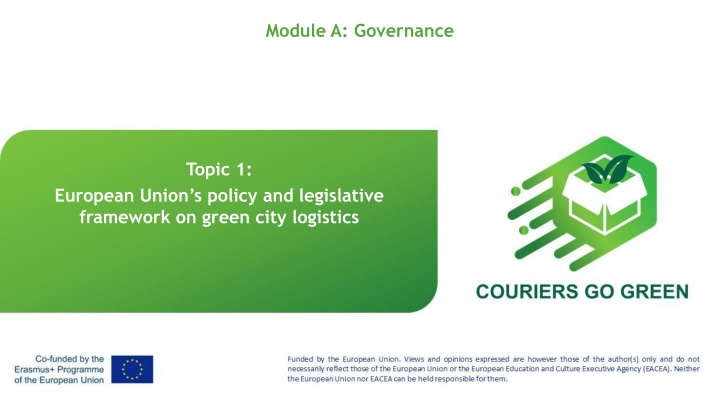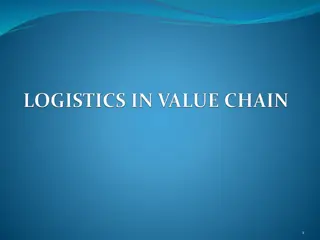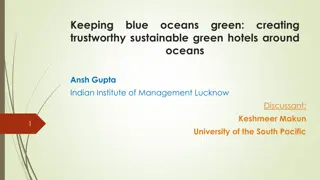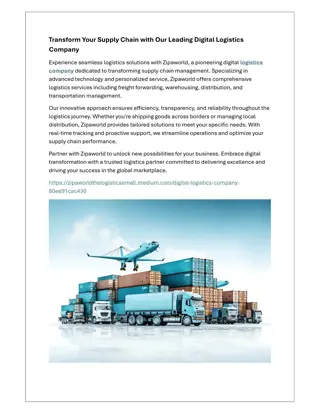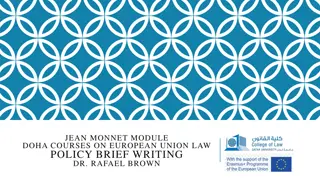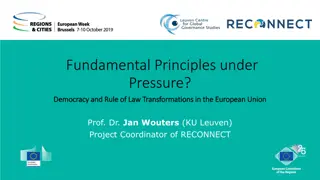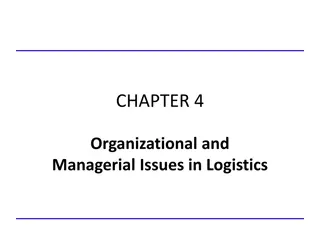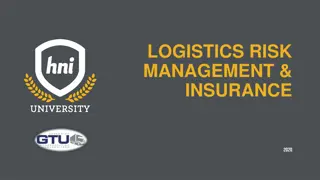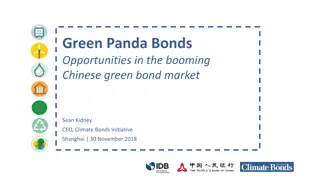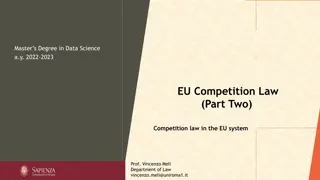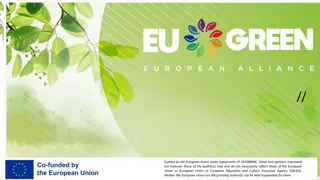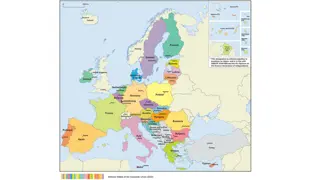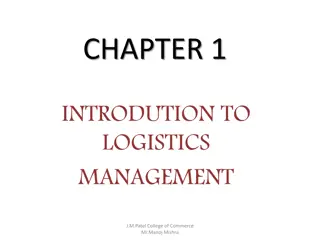European Union's Green City Logistics Policy
Green urban logistics in European cities aims to minimize environmental impact through optimized routes, reduced emissions, and sustainable practices. Implementing green logistics faces challenges but offers benefits such as reduced carbon footprint and improved air quality.
Download Presentation

Please find below an Image/Link to download the presentation.
The content on the website is provided AS IS for your information and personal use only. It may not be sold, licensed, or shared on other websites without obtaining consent from the author.If you encounter any issues during the download, it is possible that the publisher has removed the file from their server.
You are allowed to download the files provided on this website for personal or commercial use, subject to the condition that they are used lawfully. All files are the property of their respective owners.
The content on the website is provided AS IS for your information and personal use only. It may not be sold, licensed, or shared on other websites without obtaining consent from the author.
E N D
Presentation Transcript
Module A: Governance Topic 1: European Union s policy and legislative framework on green city logistics 1
Contents 1. Understanding Green Urban Logistics 2. EU's Strategic Framework and Policies 3. Implementing the Green Transition A. Governance 1. European Union s policy and legislative framework on green city logistics 2
1. Understanding Green Urban Logistics: The Concept of Green Urban Logistics Defining Green Logistics Green urban logistics refers to the efforts to minimize the environmental impact of the logistics sector within urban areas. This involves optimizing transportation routes, reducing emissions, and implementing sustainable practices in the delivery of goods and services. Importance for Cities As urban areas grow, the demand for efficient delivery services increases. Green urban logistics is crucial for reducing traffic congestion, improving air quality, and enhancing the overall sustainability of cities. Challenges Faced The shift to green logistics comes with challenges such as the need for investment in new technologies, resistance to change from established logistics providers, and the complexity of coordinating multiple stakeholders. A. Governance 1. European Union s policy and legislative framework on green city logistics 3
1. Understanding Green Urban Logistics: Environmental Impact of Urban Logistics Emissions and Pollution Resource Consumption Noise and Congestion The logistics sector is a significant contributor to greenhouse gas emissions and air pollution in cities, primarily due to the use of fossil fuels in transportation. Urban logistics operations consume resources, including energy and space, contributing to the environmental footprint of cities. Besides emissions, logistics activities contribute to noise pollution and traffic congestion, affecting the quality of life in urban areas. A. Governance 1. European Union s policy and legislative framework on green city logistics 4
1. Understanding Green Urban Logistics: Benefits of Green Urban Logistics By adopting green logistics practices, cities can significantly reduce their carbon footprint and contribute to climate change mitigation efforts. Reduced Carbon Footprint Improved air quality and reduced noise pollution lead to healthier living conditions for urban residents. Healthier Communities Green logistics can lead to cost savings through more efficient resource use and can stimulate economic growth by creating new green jobs. Economic Efficiency A. Governance 1. European Union s policy and legislative framework on green city logistics 5
1. Understanding Green Urban Logistics: Key Components of Green Urban Logistics Sustainable Transportation Modes Smart Planning and Routing Collaborative Efforts Encouraging partnerships between businesses, government, and the community to develop and implement green logistics solutions. Emphasizing the use of electric vehicles, bicycles, and other low-emission transport options for last-mile delivery. Utilizing advanced software and data analytics to optimize delivery routes and reduce unnecessary travel. A. Governance 1. European Union s policy and legislative framework on green city logistics 6
2. EU's Strategic Framework and Policies: The European Green Deal International Cooperation Policy Initiatives Vision for 2050 The EU aims to lead by example and foster It includes initiatives like revising CO2 The European Green Deal outlines the EU's international cooperation to ensure a emission standards, promoting electric and commitment to becoming a climate-neutral global approach to green logistics. hydrogen vehicles, and developing new continent by 2050, with a significant focus distribution models. on transforming the transport sector. https://commission.europa.eu/strategy-and-policy/priorities-2019-2024/european-green-deal_en A. Governance 1. European Union s policy and legislative framework on green city logistics 7
2. EU's Strategic Framework and Policies: Sustainable Urban Mobility Plans (SUMPs) Framework for Cities Stakeholder Engagement SUMPs provide a strategic approach for cities to develop sustainable mobility strategies, including urban logistics. These plans emphasize the importance of involving all relevant stakeholders, from logistics providers to local communities, in the planning process. Incorporating SULP The Sustainable Urban Logistics Planning (SULP) is integrated within SUMPs to specifically address the challenges of urban freight transportation. https://transport.ec.europa.eu/transport-themes/urban-transport/sustainable-urban-mobility- planning-and-monitoring_en A. Governance 1. European Union s policy and legislative framework on green city logistics 8
2. EU's Strategic Framework and Policies: Legislation and Directives Clean Vehicles Directive Alternative Fuels Infrastructure Directive Renewable Energy Directive This directive sets out requirements for public bodies to procure clean and energy-efficient vehicles, influencing urban logistics fleets. It aims to develop infrastructure for alternative fuels, such as electric charging stations, to support green logistics. This directive promotes the use of renewable energy sources within the transport sector, including logistics operations. A. Governance 1. European Union s policy and legislative framework on green city logistics 9
3. Implementing the Green Transition: Policy Actions and Investments Sustainability Commitments Digital Infrastructure Stimulus Packages Requiring transport operators to commit to Investing in digital solutions to Designing economic recovery sustainability measures as a condition for improve the efficiency of urban packages that prioritize low-carbon receiving support. transport to leverage the shift logistics and encourage sustainable towards green logistics. transport options. A. Governance 1. European Union s policy and legislative framework on green city logistics 10
3. Implementing the Green Transition: Overcoming Challenges in Green Logistics Cross-Sectoral Collaboration Public Acceptance Innovative Technologies Creating governance structures that can address the multifaceted challenges of decarbonizing transport. Increasing support for innovative technologies and services that can have a significant impact on reducing emissions in logistics. Communicating the benefits of green logistics to citizens to gain their support and involvement in the transition. A. Governance 1. European Union s policy and legislative framework on green city logistics 11
3. Implementing the Green Transition: Monitoring and Adjusting Policies Regular Policy Updates Implementing mechanisms for regular updates to policies and infrastructure investments to adapt to changing conditions. Transparency and Collaboration Helping companies in the transport sector by providing clear information on policy development and support programs. Evaluating Impact Establishing robust monitoring and evaluation mechanisms to assess the effectiveness of green logistics initiatives. A. Governance 1. European Union s policy and legislative framework on green city logistics 12
3. Implementing the Green Transition: Education and Certification Curricular Inclusion Integrating the principles of green urban logistics into educational curricula to raise awareness and understanding among students. Empowering the Next Generation Encouraging youth involvement in green logistics through educational programs and leadership development initiatives. Certifying personnel for sustainable courier practices has several benefits, including improving environmental performance, meeting the growing demand for sustainable courier services, distinguishing trained personnel, and serving as a professional achievement for individuals. Certification A. Governance 1. European Union s policy and legislative framework on green city logistics 13
Corkery, Michael; Creswell, Julie (2 November 2021). "Corporate Climate Pledges Often Ignore a Key Component: Supply Chains". The New York Times. ISSN 0362-4331. Retrieved 20/04/2024 from https://www.nytimes.com/2021/11/02/business/corporate-climate-pledge-supply-chain.html References Couriers Go Green (May 2023). State Analysis Assessment Report . Retrieved 08/05/2024. European Commission (2018). A Clean Planet for all - A European strategic long-term vision for a prosperous, modern, competitive and climate neutral economy . Retrieved 20/04/2024 from https://eur-lex.europa.eu/legal- content/EN/TXT/?uri=CELEX%3A52018DC0773 European Commission (2019). Clean Vehicles Directive. Retrieved 08/05/2024 from https://eur- lex.europa.eu/eli/dir/2019/1161/oj European Commission (2023). Renewable Energy Directive. Retrieved 08/05/2024 from https://eur-lex.europa.eu/legal- content/EN/TXT/?uri=CELEX%3A32023L2413&qid=1699364355105 European Commission (2021). Alternative Fuels Infrastructure. Retrieved 08/05/2024 from https://transport.ec.europa.eu/transport-themes/clean-transport/alternative-fuels-sustainable-mobility-europe/alternative- fuels-infrastructure_en European Commission. CO emission performance standards for cars and vans. Retrieved 08/05/2024 from https://climate.ec.europa.eu/eu-action/transport/road-transport-reducing-co2-emissions-vehicles/co2-emission-performance- standards-cars-and-vans_en European Commission. Sustainable urban mobility planning and monitoring. Retrieved 08/05/2024 from https://transport.ec.europa.eu/transport-themes/urban-transport/sustainable-urban-mobility-planning-and-monitoring_en A. Governance 1. European Union s policy and legislative framework on green city logistics 14
A. Governance 1. European Unions policy and legislative framework on green city logistics Thank you for your attention! 15
